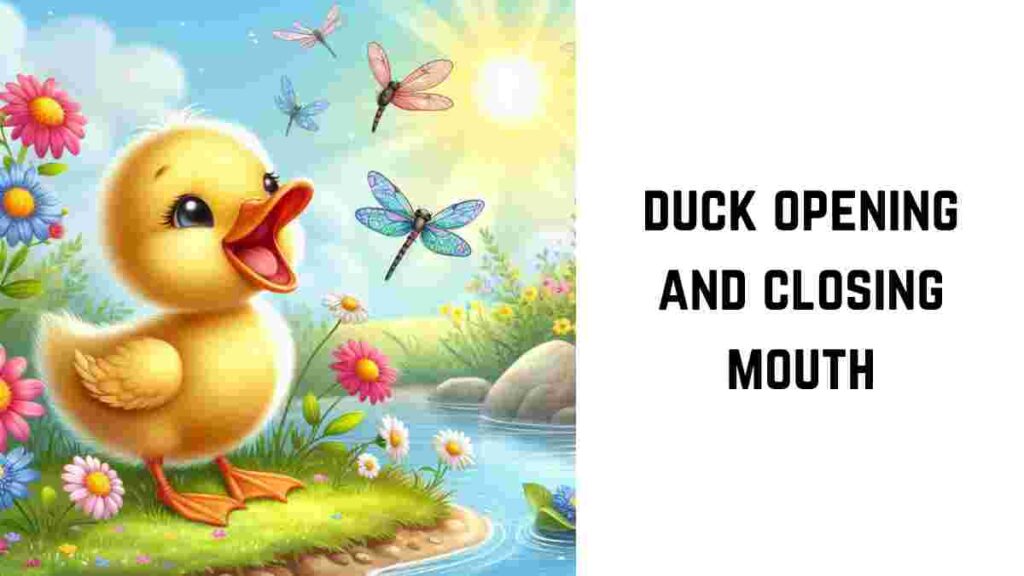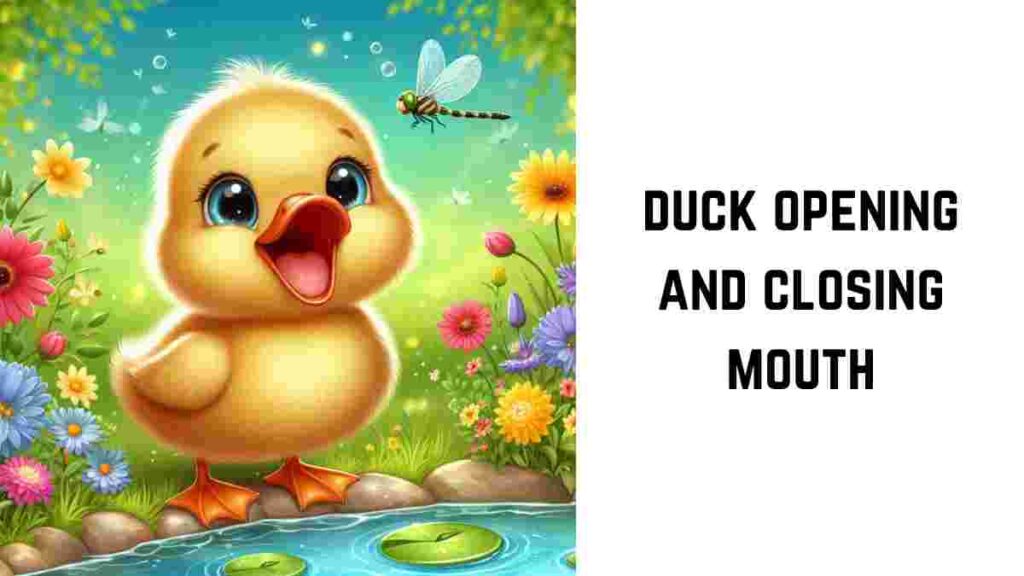Duck Opening and Closing Mouth: Ducks, belonging to the family Anatidae, are among the most well-known and studied waterfowl. Their behavior, particularly the opening and closing of their mouths, holds significant importance in various biological and ecological contexts.
This article delves into the anatomy, behavior, and underlying mechanisms of this fascinating phenomenon.
Find the best food for your chickens

Table of Contents
Anatomy of a Duck’s Mouth – Duck Opening and Closing Mouth
To understand the mechanics of a duck’s mouth movements, it’s essential to first grasp the anatomy involved. A duck’s mouth comprises several key components:
- Bill: The external structure, often referred to as the beak, is composed of the upper mandible and the lower mandible.
- Tongue: Plays a crucial role in manipulating food and aiding in the process of swallowing.
- Lamellae: Comb-like structures along the edges of the bill that help filter food from water.
- Muscles: Various muscles control the movement of the bill, enabling the duck to open and close its mouth efficiently.
Functions of Mouth Movements in Ducks
The opening and closing of a duck’s mouth serve several critical functions:
- Feeding: Ducks use their bills to catch and manipulate food. They can filter small organisms and plants from the water using their lamellae.
- Communication: Ducks often open and close their mouths to produce vocalizations. These sounds can serve as communication signals within flocks or between mates.
- Thermoregulation: Similar to panting in dogs, ducks can open their mouths to help regulate their body temperature, particularly in hot weather.
- Grooming: Ducks use their mouths to preen their feathers, which helps in maintaining their plumage and removing parasites.
Feeding Behavior and Techniques
Ducks exhibit a variety of feeding behaviors, which often involve distinct mouth movements. The primary feeding techniques include:
- Dabbling: Ducks dip their heads into the water while keeping their bodies afloat. They open and close their mouths to filter food particles from the water.
- Diving: Some species dive underwater to catch fish or aquatic invertebrates. Mouth movements are crucial in capturing and consuming prey.
- Grazing: Ducks also feed on land, where they use their bills to peck at grass, seeds, and insects.
Table 1: Comparative Analysis of Feeding Techniques in Ducks
| Feeding Technique | Mouth Movement Description | Typical Species | Example Food Items |
|---|---|---|---|
| Dabbling | Rapid opening and closing | Mallard | Algae, small invertebrates |
| Diving | Precise and forceful | Merganser | Fish, crustaceans |
| Grazing | Pecking and biting | Northern Shoveler | Grass, seeds |

Vocal Communication
Vocalizations are a significant aspect of duck behavior, with mouth movements playing a central role. Ducks produce a range of sounds, including quacks, whistles, and grunts, each serving different communicative purposes.
- Mating Calls: During the breeding season, ducks open and close their mouths to produce calls that attract mates.
- Alarm Calls: When threatened, ducks emit loud calls to alert other members of their flock.
- Contact Calls: Ducks often use softer sounds to maintain contact with each other while foraging or during flight.
Thermoregulation
Ducks, like many other birds, have limited sweat glands. To cool down, they may open their mouths and engage in a behavior similar to panting. This increases the evaporation of water from the respiratory tract, helping to dissipate excess body heat.
Grooming and Preening
Preening is vital for maintaining feather health. Ducks open and close their mouths while running their bills through their feathers, distributing oils produced by the preen gland. This behavior ensures waterproofing and insulation, which are crucial for their survival in aquatic environments.
Physiological Mechanisms
The opening and closing of a duck’s mouth involve a complex interplay of muscles and nerves. The primary muscles involved include:
- Depressor Mandibulae: Responsible for lowering the lower mandible.
- Protractor Pterygoideus: Helps in protruding the upper mandible.
- Adductor Mandibulae: Used for closing the mandibles together.
Table 2: Key Muscles Involved in Duck Mouth Movements
| Muscle Name | Function |
|---|---|
| Depressor Mandibulae | Lowers the lower mandible |
| Protractor Pterygoideus | Protrudes upper mandible |
| Adductor Mandibulae | Closes the mandibles |
Behavioral Observations in Various Species
Different species of ducks exhibit variations in their mouth movements based on their ecological niches and feeding habits.
- Mallard (Anas platyrhynchos): Known for their dabbling behavior, mallards frequently open and close their mouths to sift through water and mud for food.
- Common Merganser (Mergus merganser): A diving species, these ducks have more forceful and precise mouth movements to catch fish.
- Northern Shoveler (Spatula clypeata): With a uniquely shaped bill, these ducks graze and filter feed, showing distinct lateral mouth movements.
Adaptations and Evolution
The evolution of mouth movements in ducks can be traced back to their adaptation to diverse ecological niches. The structure and function of their bills have evolved to optimize feeding efficiency, vocal communication, and other behaviors.
Table 3: Evolutionary Adaptations in Duck Bill Structure
| Species | Bill Shape | Primary Adaptation |
|---|---|---|
| Mallard | Broad and flat | Filtering and grazing |
| Common Merganser | Narrow and serrated | Catching fish |
| Northern Shoveler | Wide and spoon-shaped | Filtering small organisms |

Frequently Asked Questions (FAQ) – Duck Opening and Closing Mouth
Why do ducks open and close their mouths while swimming?
Ducks often open and close their mouths while swimming to filter food from the water, a behavior known as dabbling.
Do all ducks produce vocal sounds by opening and closing their mouths?
Yes, most duck species use mouth movements to produce a variety of vocal sounds for communication.
How does mouth movement help in duck thermoregulation?
By opening their mouths and engaging in panting-like behavior, ducks can increase evaporative cooling from their respiratory tract, helping to regulate their body temperature.
Are there any specific muscles responsible for duck mouth movements?
Yes, muscles like the depressor mandibulae, protractor pterygoideus, and adductor mandibulae play key roles in controlling duck mouth movements.
How do different feeding techniques influence duck mouth movements?
Feeding techniques such as dabbling, diving, and grazing require distinct mouth movements tailored to the specific food acquisition method.
Conclusion – Duck Opening and Closing Mouth
The opening and closing of a duck’s mouth are multifaceted behaviors influenced by anatomy, feeding habits, communication needs, and physiological processes. Understanding these movements offers valuable insights into the life and ecology of these fascinating waterfowl. Ducks have evolved a range of specialized adaptations that enable them to thrive in diverse environments, making their study both intriguing and essential for avian biology.
You May Also Like
Additional Knowledge: Comparative Analysis with Other Birds
While ducks have unique adaptations, comparing their mouth movements with other bird species can provide a broader perspective. For instance, the feeding behavior of pelicans, which use their large bills to scoop up fish, or the pecking habits of woodpeckers, which rely on rapid bill movements to drill into wood, highlight the diversity of avian feeding strategies.
Table 4: Comparative Analysis of Bill Functions in Different Birds
| Bird Species | Bill Function | Feeding Technique |
|---|---|---|
| Pelican | Scooping | Fish catching |
| Woodpecker | Drilling and pecking | Insect hunting in wood |
| Hummingbird | Probing | Nectar feeding |
| Duck (General) | Filtering, pecking, catching | Dabbling, grazing, diving |
By examining the opening and closing of a duck’s mouth within this broader avian context, we gain a deeper appreciation of the evolutionary diversity and specialization present in the bird world. This understanding not only enriches our knowledge of ducks but also enhances our overall comprehension of avian biology and ecology.
